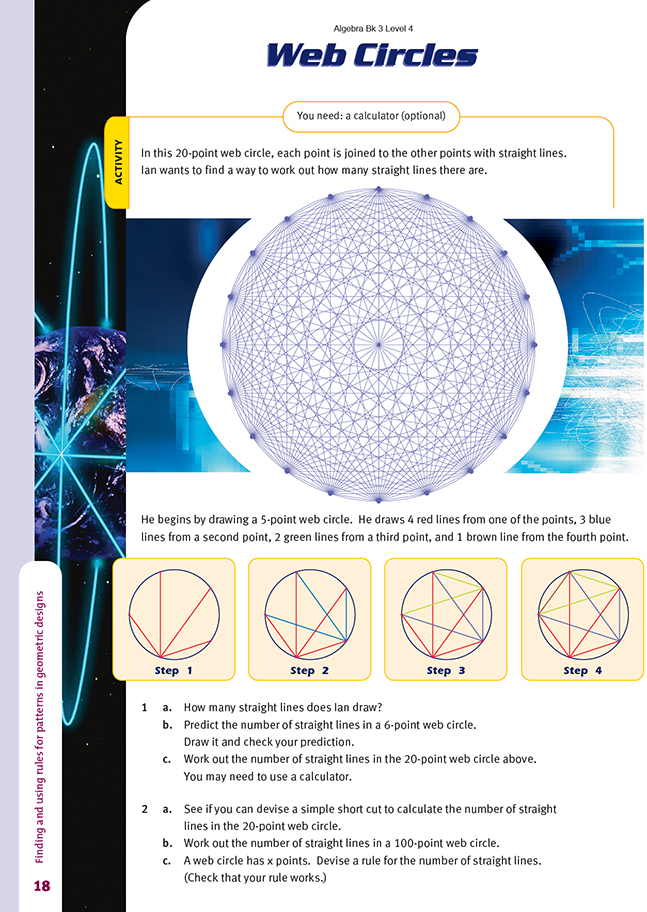This is a level 5 algebra strand activity from the Figure It Out series.
A PDF of the student activity is included.
Click on the image to enlarge it. Click again to close. Download PDF (196 KB)
find a rule for a geometric pattern
calculator (optional)
FIO, Level 4, Algebra, Book Three, Web Circles, page 18
In this activity, the students find a rule to predict the number of straight lines in any web circle. It is soon clear that simply counting the lines will not be possible. An alternative strategy is needed. Ian decides to start with a web circle with just 5 points. He is able to easily count the 10 lines he has drawn and should see clearly that 4 lines radiate from each of the points, so there are 5 x 4 = 20 straight lines. But this counts
each line twice (each line gets counted at both points where it meets the circle), so there are in fact 20 ÷ 2 = 10 straight lines.
This method can be used for web circles with any number of points. If there are x points, there are always (x – 1) straight lines to that point, and therefore a total of 1/2 x x x (x – 1) straight lines. This can be written as
![]()
If the students have worked through Problem Smorgasboard on page 13 of the student book, they may realise that the last problem on that page is identical to this one in terms of the mathematics involved.
On page 13, we have people; here we have points. In each case, we have to work out the number of connections that can be made between members of the group. If there are 30 people, every one of them can connect with all but themselves, that is, with 29 people. But 30 x 29 counts each connection twice, so there are 1/2 x 30 x 29 = 435 distinct connections. In this activity, there are 20 points, each able to connect with every point but itself, that is, 19 points. 1/2 x 20 x 19 = 190.
Answers to Activity
1. a. 10. (There are 4 red + 3 blue + 2 green + 1 brown = 10 straight lines.)
b. 5 + 4 + 3 + 2 + 1 = 15 straight lines.gif)
c. 190. (19 + 18 + 17 + 16 + 15 + 14 + 13 + 12 + 11 + 10 + 9 + 8 + 7 + 6 + 5 + 4 + 3 + 2 + 1 = 190 straight lines)
2. a. Answers will vary. One way is to use Ian’s approach and then rearrange the numbers from 19 to 1 like this: (19 + 1) + (18 + 2) + … + (12 + 8) + (11 + 9) + 10.
The value for the sum in each of the 9 pairs of brackets is 20, or 10 + 10. There are 19 sets of 10 altogether, so the short cut is 19 x 10 = 190 straight lines.
A simpler approach is to consider the number of points in the web circle and the number of straight lines going to each point. In the 20-point web circle, there are 19 straight lines for each point (1 to every other point), so there is a total of 20 x 19 = 380 straight lines. However, this method counts each line twice (each line gets counted at both the points that it joins), so the actual number is 380 ÷ 2 = 190.
The short cut for this is 20 x 19 ÷ 2 = 190.
b. 4 950. (Using the short cuts above, this is 99 x 50, or 100 x 99 ÷ 2.)
c. Based on the short cuts in b, a rule for x points would be
![]()
